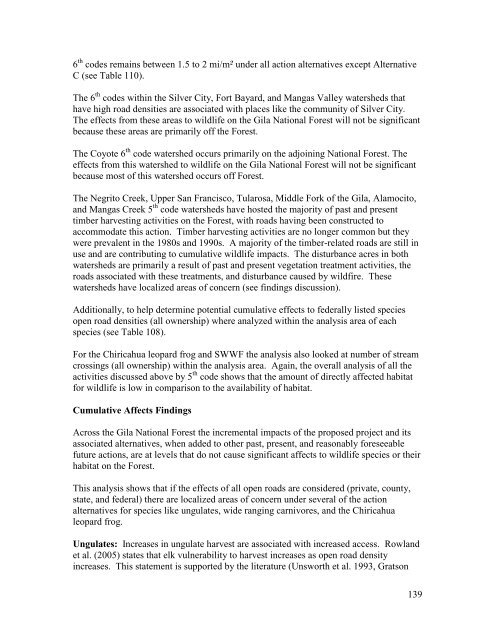Wildlife Specialist report
Wildlife Specialist report
Wildlife Specialist report
Create successful ePaper yourself
Turn your PDF publications into a flip-book with our unique Google optimized e-Paper software.
6 th codes remains between 1.5 to 2 mi/m² under all action alternatives except Alternative<br />
C (see Table 110).<br />
The 6 th codes within the Silver City, Fort Bayard, and Mangas Valley watersheds that<br />
have high road densities are associated with places like the community of Silver City.<br />
The effects from these areas to wildlife on the Gila National Forest will not be significant<br />
because these areas are primarily off the Forest.<br />
The Coyote 6 th code watershed occurs primarily on the adjoining National Forest. The<br />
effects from this watershed to wildlife on the Gila National Forest will not be significant<br />
because most of this watershed occurs off Forest.<br />
The Negrito Creek, Upper San Francisco, Tularosa, Middle Fork of the Gila, Alamocito,<br />
and Mangas Creek 5 th code watersheds have hosted the majority of past and present<br />
timber harvesting activities on the Forest, with roads having been constructed to<br />
accommodate this action. Timber harvesting activities are no longer common but they<br />
were prevalent in the 1980s and 1990s. A majority of the timber-related roads are still in<br />
use and are contributing to cumulative wildlife impacts. The disturbance acres in both<br />
watersheds are primarily a result of past and present vegetation treatment activities, the<br />
roads associated with these treatments, and disturbance caused by wildfire. These<br />
watersheds have localized areas of concern (see findings discussion).<br />
Additionally, to help determine potential cumulative effects to federally listed species<br />
open road densities (all ownership) where analyzed within the analysis area of each<br />
species (see Table 108).<br />
For the Chiricahua leopard frog and SWWF the analysis also looked at number of stream<br />
crossings (all ownership) within the analysis area. Again, the overall analysis of all the<br />
activities discussed above by 5 th code shows that the amount of directly affected habitat<br />
for wildlife is low in comparison to the availability of habitat.<br />
Cumulative Affects Findings<br />
Across the Gila National Forest the incremental impacts of the proposed project and its<br />
associated alternatives, when added to other past, present, and reasonably foreseeable<br />
future actions, are at levels that do not cause significant affects to wildlife species or their<br />
habitat on the Forest.<br />
This analysis shows that if the effects of all open roads are considered (private, county,<br />
state, and federal) there are localized areas of concern under several of the action<br />
alternatives for species like ungulates, wide ranging carnivores, and the Chiricahua<br />
leopard frog.<br />
Ungulates: Increases in ungulate harvest are associated with increased access. Rowland<br />
et al. (2005) states that elk vulnerability to harvest increases as open road density<br />
increases. This statement is supported by the literature (Unsworth et al. 1993, Gratson<br />
139
















